“
Consider the ant thou sluggard
”Proverbs 6:6-8
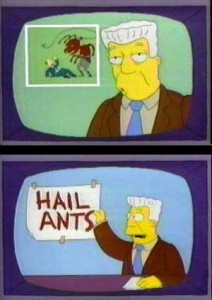 Ants are amazing insects, so much so the Bible instructs us to look at their lives for examples of work, efficiency, cleanliness and team work. There are so many different ants in the world and all are unique to each other in some ways. Just some of their names indicate the differences. Carpenter Ants, Pharaoh Ants, Leaf Cutter Ants, Thief Ants, Acrobatic Ants, Velvet Ants, Army Ants, Fire Ants, Big Headed Ants, and on and on. Most folks can’t tell the difference between ants so they give them names based on their similarities or habits. Such as pavement ants, sugar ants, grease ants, wood or bull ants, etc.etc. Regardless of the names when ants enter our homes and yards it’s time to act and when your dealing these pests you’ll need some know how to be successful.
Ants are amazing insects, so much so the Bible instructs us to look at their lives for examples of work, efficiency, cleanliness and team work. There are so many different ants in the world and all are unique to each other in some ways. Just some of their names indicate the differences. Carpenter Ants, Pharaoh Ants, Leaf Cutter Ants, Thief Ants, Acrobatic Ants, Velvet Ants, Army Ants, Fire Ants, Big Headed Ants, and on and on. Most folks can’t tell the difference between ants so they give them names based on their similarities or habits. Such as pavement ants, sugar ants, grease ants, wood or bull ants, etc.etc. Regardless of the names when ants enter our homes and yards it’s time to act and when your dealing these pests you’ll need some know how to be successful.
Carpenter Ants are rather large in the ant world and can be quite destructive to wood in our homes. They do not eat the wood ( contrary to popular belief ) but hew out chambers for the colony. In some states you’d be unable to sell your home without first passing a Carpenter Ant inspection. Part of the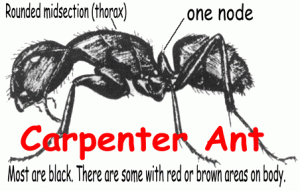 problem in treating these ants is that you are dealing with a colony and as many as 5 other satellite colonies. If you are fortunate enough to find a nest you still have 4 or 5 more that will rebuild, re-establish support and defend the entire population. Other challenges these ants present is that they are primarily nocturnal, travel above and below ground, can live in almost any location and do not necessarily walk along ‘ant trails’ such as we’re used to. This makes tracking them and finding the nest extremely difficult. Add to that, they are finicky eaters and there aren’t many bait products out there that work really well. Your best option for treating these ants is ‘non-repellent’ liquids that they cannot detect, walk on and take back to the nest doing the work for you. If you know of a infestation in your wall ( usually indicated by ‘frass’ or sawdust that drops down from say a small hole in your window sill). You would at that point drill a small hole into the area of the hole and inject your chosen pest product into their galleries. Such products include Phantom, Termidor, Drione Dust,etc.. Treating suspected walkways and nesting areas with non-repellents will not give immediate results but soon the entire colony will fall.
problem in treating these ants is that you are dealing with a colony and as many as 5 other satellite colonies. If you are fortunate enough to find a nest you still have 4 or 5 more that will rebuild, re-establish support and defend the entire population. Other challenges these ants present is that they are primarily nocturnal, travel above and below ground, can live in almost any location and do not necessarily walk along ‘ant trails’ such as we’re used to. This makes tracking them and finding the nest extremely difficult. Add to that, they are finicky eaters and there aren’t many bait products out there that work really well. Your best option for treating these ants is ‘non-repellent’ liquids that they cannot detect, walk on and take back to the nest doing the work for you. If you know of a infestation in your wall ( usually indicated by ‘frass’ or sawdust that drops down from say a small hole in your window sill). You would at that point drill a small hole into the area of the hole and inject your chosen pest product into their galleries. Such products include Phantom, Termidor, Drione Dust,etc.. Treating suspected walkways and nesting areas with non-repellents will not give immediate results but soon the entire colony will fall.
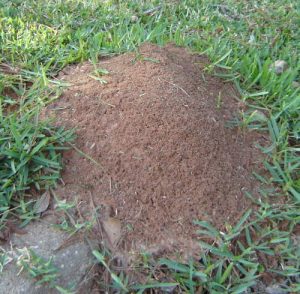 Fire Ants, not native to America but were transported here on ships from tropical regions. This ant is a very dominant and will take over your yard & home if you give them a chance. Characteristic mounds are a tail tell sign the invasion is on. These ants eat just about anything and will follow cable lines, expansion joints in cement or just trail up and into your home when so inclined. Fire Ants do bite but it’s the stinger that gives the victim those painful little pustules. They have a unique way of climbing up on your leg or feet and all biting/stinging at the same time. Some folks have severe reactions to the venom but to most it’s just a painful reminder to watch where we step. Control of these ants has come along way from the ‘gallon per mound’ drenching. Some baits such as Amdro
Fire Ants, not native to America but were transported here on ships from tropical regions. This ant is a very dominant and will take over your yard & home if you give them a chance. Characteristic mounds are a tail tell sign the invasion is on. These ants eat just about anything and will follow cable lines, expansion joints in cement or just trail up and into your home when so inclined. Fire Ants do bite but it’s the stinger that gives the victim those painful little pustules. They have a unique way of climbing up on your leg or feet and all biting/stinging at the same time. Some folks have severe reactions to the venom but to most it’s just a painful reminder to watch where we step. Control of these ants has come along way from the ‘gallon per mound’ drenching. Some baits such as Amdro 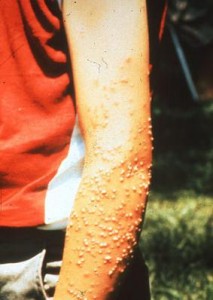 can be quite helpful or treatment granules that last an entire season will work just fine. For quickest relief call a professional who can treat your entire yard and home if need be. If you bait try to bait in the evening hours so the hot mid day sun doesn’t ‘cook’ the bait.
can be quite helpful or treatment granules that last an entire season will work just fine. For quickest relief call a professional who can treat your entire yard and home if need be. If you bait try to bait in the evening hours so the hot mid day sun doesn’t ‘cook’ the bait.
Pharaoh Ants are perhaps some of the most difficult to deal with. They are so small and you literally can’t see them unless they are moving. People spray these ants with all they have and still they keep coming. Part of the reason is that they have multiple queens in their colony and will ’split’ or ‘bud’ as a defense when attacked. So you see some, spray and now you’re dealing with 2 colonies instead of 1. Then 3, then 4. It can be quite maddening. These ants have a high need for moisture so often times you’ll find them in kitchens and bathrooms trailing on your toothbrush or in your coffee maker.
Ants in general can detect sprays easily and Pharaoh Ants are no exception. Until recently baits were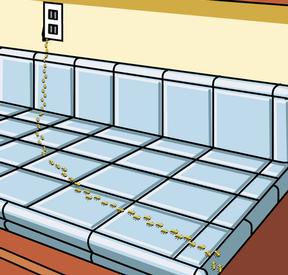 about the only effective way of reducing this pests population in your home. However baits usually only work so long and results sometimes were not as we hoped. Today’s pest products such as Phantom, Pharoid and others can be quite effective on these little buggers but need time to work through the entire colony. Baits such as Max Force Ant , Terro and others work well. Reducing food and water sources can help greatly as well. If you’re having trouble with Pharaoh Ants you might be better off by calling in the big guns right from the get go.
about the only effective way of reducing this pests population in your home. However baits usually only work so long and results sometimes were not as we hoped. Today’s pest products such as Phantom, Pharoid and others can be quite effective on these little buggers but need time to work through the entire colony. Baits such as Max Force Ant , Terro and others work well. Reducing food and water sources can help greatly as well. If you’re having trouble with Pharaoh Ants you might be better off by calling in the big guns right from the get go.




